Darrah Steffen's Blog, page 2
April 4, 2023
The Roc
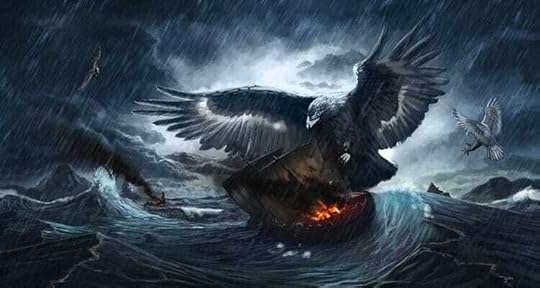
The roc is an enormous legendary bird of prey from Middle Eastern mythology. It appears in stories such as One Thousand and One Nights and Sinbad. Many stories describe the creature as taking the form of an eagle or condor of stupefying size. They are much larger than typical flying monsters and can take on dragons or carry off elephants.
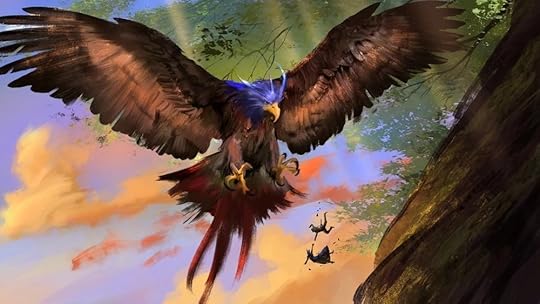
Stories of the creatures may be able to trace their origins to a fight between the Indian solar bird Garuda and the chthonic serpent Naga. Garuda carried off an elephant at the end of the Sanskrit epics.
Other stories can trace back to the 13 century to the merchant Marco Polo. He described a creature that:
“…was for all the world like an eagle, but one indeed of enormous size; so big in fact that its quills were twelve paces long and thick in proportion. And it is so strong that it will seize an elephant in its talons and carry him high into the air and drop him so that he is smashed to pieces; having so killed him, the bird swoops down on him and eats him at leisure.“
Marco Polo claimed the roc was from Madagascar and made distinctions from a griffin.
So what inspired these gargantuan creatures?
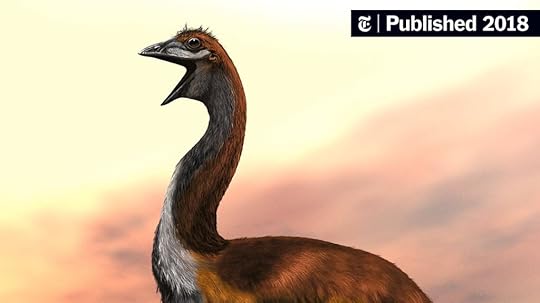
Many historians believe that the origins of the roc are due to sitings of the enormous Aepyornis or the Elephant Bird. These birds once lived in Madagascar, but went extinct, probably as a result of human activity.
These birds could be up to 3 m tall and weigh over 700 kg. Due to their large size, these creatures were flightless and looked much like ostriches or emus. Its eggs are the largest bird eggs to have ever existed, weighing 10 kg – over 150 times the size of a chicken’s egg.
Although these birds went extinct relatively recently, the fossil record for them is patchy, causing much debate about their family tree. Madagascar’s environment is not conducive to fossil preservation and causes skeletons to be fragmented.
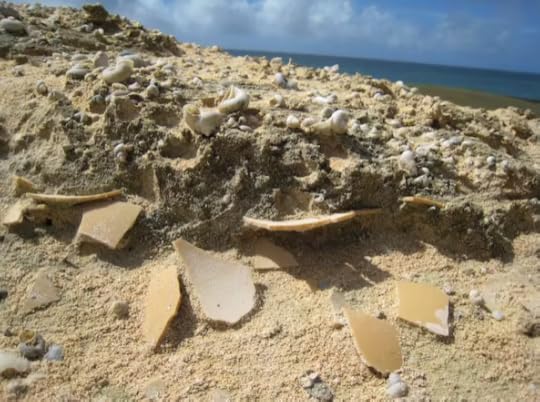
Modern technology has helped settle these disputes. Researchers started to examine the abundant eggshells preserved. Compared to other birds, elephant bird eggshell is very thick, trapping DNA inside the layers. The eggshell preserves stable isotope signatures that can be matched to plants and animals of the environment to show how these animals lived.
For example, we know switch grasses are rich in the carbon- 4 isotope. Animals such as gazelles and wildebeest come back with carbon-4 stable isotopes as they primarily eat plants that photosynthesize C4.
Physical characteristics of the eggshell can also reveal information about egg size, bird size, nesting behavior, and can sometimes even distinguish bird groups.
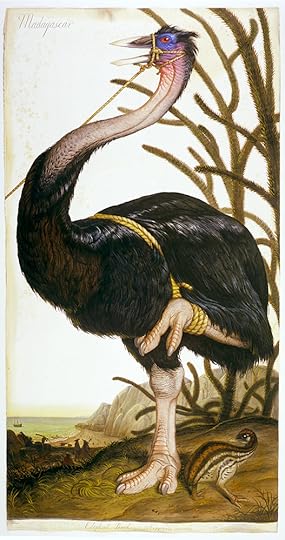
Due to its flightlessness and unusual appearance, this creature was most often mistaken as a chick of a much larger species. This led observers to believe these creatures grew into large birds of prey – later known as the Roc.
Sources:
Alicia Grealy Research Projects Officer. (2023, February 28). Extinct elephant birds were 3 metres tall and weighed 700kg. now, DNA from fossil eggshells reveals how they lived. The Conversation. Retrieved April 4, 2023, from https://theconversation.com/extinct-elephant-birds-were-3-metres-tall-and-weighed-700kg-now-dna-from-fossil-eggshells-reveals-how-they-lived-200628
C3 and C4 photosynthesis. Student Materials. (2018, January 11). Retrieved April 4, 2023, from https://serc.carleton.edu/integrate/teaching_materials/food_supply/student_materials/1167#:~:text=As%20a%20result%20in%20high,sugarcane%2C%20millet%2C%20and%20switchgrass.
Roc Birds. TV Tropes. (n.d.). Retrieved April 4, 2023, from https://tvtropes.org/pmwiki/pmwiki.php/Main/RocBirds
Tyson, Peter (2000). The Eighth Continent. New York. pp. 138–139.
Ubierna, N., Holloway-Phillips, M.-M., & Farquhar, G. D. (2018). Using stable carbon isotopes to study C3 and C4 photosynthesis: Models and calculations. Methods in Molecular Biology, 155–196. https://doi.org/10.1007/978-1-4939-7786-4_10
Uno, K. T., Cerling, T. E., Harris, J. M., Kunimatsu, Y., Leakey, M. G., Nakatsukasa, M., & Nakaya, H. (2011). Late miocene to pliocene carbon isotope record of differential diet change among East African herbivores. Proceedings of the National Academy of Sciences, 108(16), 6509–6514. https://doi.org/10.1073/pnas.1018435108
March 21, 2023
The Piasa Bird

Thousands of ancient pictographs are carved or painted on rocks along the Mississippi River between Illinois and Missouri. For hundreds of years, explorers have described these images, townspeople whispered about them, and archeologists recorded their findings. The most curious image is that of the Piasa.
The Piasa is a creature from Native American mythology depicted in two murals along the limestone bluffs in Madison County, Illinois. The original illustration has long since weathered away, but a new version has replaced it based on 19th-century sketches.
The sketch depicts a creature called the Piasa. It is supposedly as large as a calf, but had antlers and red eyes and scales or feathers covering the body as well as a tail that could completely wrap around its body. The original descriptions of the cave painting make no mention of wings, but modern depictions show the creature sporting large wings and it is often referred to as a “Piasa Bird.”
So what inspired this painting?
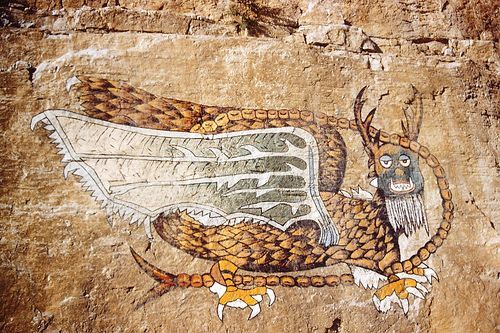 1934 restoration of the Piasa
1934 restoration of the PiasaThe first European record of the Piasa comes from Father Jacques Marquette during his 1673 journey down the Mississippi River with Louis Jolliet. He described the painting on the bluffs near modern-day Alton, IL. However, he found it difficult to believe it was painted by the Indigenous people of the area. He did not believe even the most talented French painters would have been about to complete the work. Neither his nor Jolliet’s journal of the expedition made any mention of the pictograph’s significance and his original sketch did not survive.
It was not until John Russell moved to Illinois in the 1830’s that interest was once more sparked by those of European descent. He wrote in several Illinois papers of a winged demon that terrorized the native peoples of the region. He called it the “Piasa” – which Russell claimed was an Illini word meaning “the bird that devours men.” He stated the creature could carry off deer in its talons, but once it tasted human flesh it would eat nothing else. Entire villages were destroyed and the Illini realized the Piasa must be destroyed.
Russell went on to claim that an Illini chief prayed to the Great Spirit for guidance. The chief was directed to select twenty of his best warriors. The chief acted as live bait. As the bird swooped down to seize the chief, the warriors emerged and shot the beast. The painting was to commemorate the victory.
 1999 restoration of the Piasa
1999 restoration of the PiasaModern scholars believe that Russell’s story was mostly fabricated, drawing on a number of sources including the 1833 autobiography of Black Hawk. In this autobiography, Black Hawk reminisced about living on Diamond Island where a spirit lived in a cave in the rocks. This spirit was a giant creature with large wings like a swan. Russell also changed his story several times over the years, further leading scholars to believe it was fabricated.
So what could have inspired the original drawing?

Some scholars believe the Piasa is based on the Califonia condor. The California Condor is the largest North American land bird. Its plumage is black with patches of white and has a bald head with yellow or orange skin. The bird’s wingspan is the widest of any North American bird reaching up to 3.0 m and weighing up to 12 kg. The condor is mainly a scavenger and eats carrion.
Looking at the Califonia Condor, it may be surprising to see how the animal could be mistaken for the animal painted on the cliff face. It may also be surprising to think about this now coastal animal being spotted in the central United States.
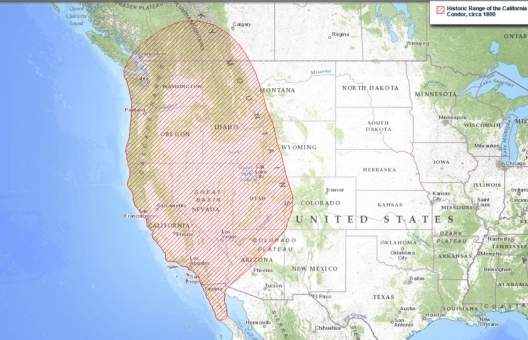 Condor range in 1800s
Condor range in 1800sIn 1987, all wild condors became extinct. The species only survived in captivity. This species declined dramatically – along with Bald and Golden Eagles – due to the use of an agricultural chemical (DDT) that weakened their eggshells. This prevented their population from replenishing itself. The populations further declined due to poaching and habitat destruction. These animals were put on the critically endangered list. Since the condor population had grown from 27 to 537 as of December 2022.
However, the condor population has not always so diminished. When European settlers came to the western United States, condors could be found across the Rocky Mountain region. Researchers believe the Piasa painting dates back to AD 1000 to 1500, much earlier than range maps exist for.
This species covered North America during the Ice Age. California condor bones can be seen even down in southern Florida. It was not until the extinction of the Ice Age megafauna and American westward expansion that pushed the condors to small range they live today. It is highly likely the condors would have still been present in Illinois when the Piasa was painted.

Condors evolved during the Pleistocene Epoch. As the climate changed, the California Condor became the only remaining member of its family. They evolved to eat the large megafauna that is extinct today (i.e. mammoths, rhinos, camels, etc.). Today, they still prefer to feast on large, terrestrial mammalian carcasses such as deer, goats, horses, cougars, bears, or cattle. It was widely thought that they would scavenge most of their food, however, condors prefer a fresh kill. They do not have a well-developed sense of smell, so scavenging is done by sight and when necessary.
Their size is advantageous when taking down prey or intimidating scavengers away from a carcass. It is possible that the Piasa was inspired when someone saw a condor fighting with another predator over a deer carcass or something similar.

The Piasa painting requires frequent maintenance. The people of Alton take great care to ensure the care of their mysterious creature. Visitors can walk up to the painting and read the historical markers explaining its history. The local high school has even taken the creature as their mascot.
As for the California Condor, this creature also requires constant maintenance. Their conservation project may be one of the most expensive projects in US history, costing over $35 million since WWII. If you are interested in learning more about helping the condor, click here.
Sources:
“California Condor Life History”. Ventana Wildlife Society. Archived from the original on July 30, 2007.
Dunphy, J. J. (2021, December 17). The Piasa Bird: More fiction than fact. Medium. Retrieved March 19, 2023, from https://johnjdunphy.medium.com/the-piasa-bird-more-fiction-than-fact-208dff9f669
Great Rivers and Routes. (n.d.). Piasa Bird. Great Rivers & Routes. Retrieved March 19, 2023, from https://www.riversandroutes.com/directory/piasa-bird/
Helping the California Condor. Audubon California. (2015, July 3). Retrieved March 19, 2023, from https://ca.audubon.org/helping-california-condor
Kirby, D. (n.d.). The Piasa Bird, Alton, Illinois. RoadsideAmerica.com. Retrieved March 19, 2023, from https://www.roadsideamerica.com/story/12165
Nielsen, John (2006). Condor: To the Brink and Back—The Life and Times of One Giant Bird. New York: Harper Perennial.
Snyder, Noel; Snyder, Helen (2000). The California Condor. Academic Press.
Sorrell, G. (2014, June 29). The tradition of the Piasa and the mysterious rock art of the Mississippi. Ancient Origins Reconstructing the story of humanity’s past. Retrieved March 19, 2023, from https://www.ancient-origins.net/myths-legends/tradition-piasa-and-mysterious-rock-art-mississippi-001452
Wagner, M. J. (n.d.). Piasa Bird. Mythic Mississippi project. Retrieved March 19, 2023, from https://mythicmississippi.illinois.edu/native-illinois/piasa-bird/
March 6, 2023
Herodotus’s Gold-Digging Ants

Herodotus was a famous Greek historian who lived during the 6th century in the Persian Empire. He wrote many tales of unknown lands. His most fascinating account was of the legendary gold-digging ants as large as foxes.
His account stated: Ants which are smaller than Dogs but larger than Foxes for some which were caught are now in the possession of the King of Persia. These Ants make for themselves burrows below the Ground, and in doing so throw up the Earth, as ants do with us, and in the same manner they look exactly like ours. This thrown up sand contains the Gold and for the sake of this sand the Indians are sent into the desert…When the Indians arrive at the place of the Gold dust to fill their bags, they fill quickly and ride away as soon as possible. For the Ants, which, as the Persians would tell, have found out what has happened through their sense of smell, are at once after them and they are exceedingly swift.“
Herodotus was not the only historian to allude to this legend. In fact, the stories extend beyond Greek and Roman influences. References to the Ant Gold exist in the Himalayan tribes.
So what inspired these prospectors?

Historians are split on what inspired this interesting legend. One camp of thinking believes that the gold-digging ants are actually are a form of giant termites.
Giant Northern Termites are known for unearthing gold in Australia. This species is closely related to cockroaches. They are the only living member of its genus and its family – though numerous fossils taxa are known. The termite is not very numerous nor do they have large colonies when left to natural conditions. However, they thrive in locations with abundant water and timber structures, becoming an agricultural pest in Northern Australia.
In more recent years, scientists have begun to rely on the insects to guide exploration. Entomologist Aaron Stewart and his colleagues analyzed samples from 22 nests of termites and the surrounding soil. These mounds were all located in known gold-rich areas. The mounts contained high concentrations of gold.
Stewart said, “The termites are not specifically selecting gold to bring to their nests. It is a consequence of their habitat. They are including material from a few meters below the surface.”

Other historians believe that a different creature is responsible for these “fox-sized ants.” The creature would be the Long Tailed Golden Marmot and the Himilayan Marmot. These species are different but are both found in the Himalayan region. The Long Tailed Golden is located more central to Asia, while the Himalayan Marmot is concentrated in the Himalayas.
Marmots live underground and dig deep burrows with mazes of interconnecting tunnels. All this burrowing throws up a lot of earth. The location they are living in is said to be rich in gold deposits. As the marmots dig up the earth, the gold particles were then found and taken by the humans of the region.
Local tribes interviewed by researchers confirmed this method of gold collection. Tales of gold being piled along tunnels in the region were abundant.

But how did a marmot get mistaken for an ant? French Ethnologist Michel Peissel believes he found the answer to that question. The Persian word for “Marmot” and “Mountain Ants” is very similar. Somewhere along the line, the words were confused, birthing the story of Gold-digging Ants.
Sources:
Choi, C. Q. (2012, December 17). Termites: So rich their nests are made of gold. Inside Science. Retrieved March 6, 2023, from https://www.insidescience.org/news/termites-so-rich-their-nests-are-made-gold
Giant Northern Termite (mastotermes darwiniensis). Giant Northern Termite (Mastotermes darwiniensis). (n.d.). Retrieved March 6, 2023, from https://www.ozanimals.com/Insect/Giant-Northern-Termite/Mastotermes/darwiniensis.html
Gold-digging ant physiology. Superpower Wiki. (n.d.). Retrieved March 6, 2023, from https://powerlisting.fandom.com/wiki/Gold-Digging_Ant_Physiology
Takin, M. (2018, October 5). Herodotus’s legendary Fox sized gold digging ants. Mishmi Takin. Retrieved March 6, 2023, from https://mishmitakin.com/blogs/news/herodotuss-legendary-fox-sized-gold-digging-ants
February 21, 2023
Catoblepas

The catoblepas is a legendary creature from Ethiopia. It is described as a mix of a cow, warthog, and hippopotamus that lived in swamps and wastelands. Its name means “to look downwards” due to its head always looking down. Its stare or breath could turn people to stone. It is often called the African version of the Gorgon.
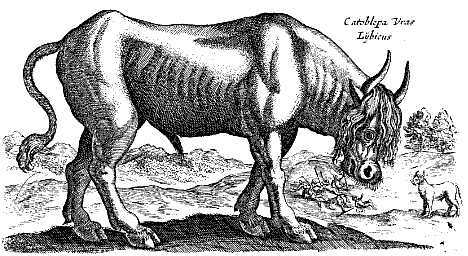
This monstrous creature was considered terrifying with a large body of a bovine, sitting atop squat legs and a long neck with a head that resembled a warthog. The catoblepas possessed a scent that reeked of death and famine, not unlike the swamp gas that filled the environment they lived.
The catoblepas possessed intelligence, grazing on grass and occasionally carrion. It was said that when the full moon shone, they ventured out to hunt for fresh meat.
So what inspired this monster?

The gnu – more commonly called wildebeest – is a group of large African antelopes. The name Wildebeest originate from Dutch meaning “wild beast.” The term “gnu” comes from the Khosian language. The terms are used interchangeably.
The gnu is a keystone species in the plain and acacia savanna ecosystems in southeastern Africa. There are several physical similarities between the gnu and the catoblepas. The gnu has a robust bovine body and a long warthog-esque face. The long face on a long neck as well as the hooded eyes gives the impression the creature is looking down.

Gnus live in a wide variety of habitats, thriving in open plains and temperate grasslands. Some species of gnus are nomadic and migrate in large herds from Tanzania to Kenya. This Great Migration seems to coincide with the changing seasons. They move to where water and food is abundant.

If you travel to Africa, you can watch the Great Migration through the Serengeti between the Ngorongoro Conservation Area in Tanzania to the Masai Mara Reserve in Kenya. Though you may not run into a catoblepas, you will see hundreds of thousands of those that inspired the legend.
Sources:
Bell, J. (2014, August 30). The GNU. A Step Ahead. Retrieved January 7, 2023, from https://www.astepahead.es/the-gnu/
Catoblepas. Forgotten Realms Wiki. (n.d.). Retrieved January 7, 2023, from https://forgottenrealms.fandom.com/wiki/Catoblepas
Encyclopædia Britannica, inc. (n.d.). GNU. Encyclopædia Britannica. Retrieved January 7, 2023, from https://www.britannica.com/animal/gnu
Glatz, K. (2022, September 21). GNU vs Wildebeest: Is there a difference? AZ Animals. Retrieved January 7, 2023, from https://a-z-animals.com/blog/gnu-vs-wildebeest/
Ham, A., Persson, B., Olum, J., & Ogutu, J. (2019). The Great Wildebeest Migration. Horizon Guide, 1–69.
McGowen, T. (1981). Encyclopedia of Legendary Creatures. Rand McNally. p. 28.
February 7, 2023
Ao Ao

Ao Ao is a monstrous creature from South American mythology – primarily Paraguay. He is said to be one of the cursed sons of the gods Tau and Kerana. He appears as a voracious sheep-like creature with large fangs and an appetite exclusively for humans.

Ao Ao is a fearsome beast. If chased by him, the only escape is climbing a palm tree – sacred in the area. If you climb any other type of tree, Ao Ao will circle the tree, howing incessantly, and dig up or knock it down. His name comes from his howl – sounding like “Ao-Ao-Ao”
So what inspired this strange beast?

The Chacoan peccary is an endangered species of peccary. A peccary is a medium-sized pig like mammal found throughout Central America, South America, and in the Caribbean.
The Chacoan peccary is the largest species of these animal, weighing over 85 lbs (40 kg). They are also the rarest species, living only in the dry Chacoan region of South America ( Paraguay, Bolivia, and Argentia). Only 3,000 remain in the world.

The Chacoan peccary was first described in 1930 based on the fossil record and was thought to be extinct. In 1971, the animal was discovered alive in Argentina. The species was well known to the local population, but took a while for the Western scientists to acknowledge its existance.
The Chacoan peccary has many pig-like features. It had hooved feet and a well defined, leathery snought. The bristle-like hair is brown to gray. These animals often travel in herds of 20 individuals. They are active in the day, especially the morning.
Peccaries are social mammals communicating by various sounds, ranging from grunts to chatters to calls. Though some inidivuals can exhibit aggressive behavior, they will not attack unless threatened.
Chacoan peccaries are herbiverous and eat the tough vegitation found in the Gran Chaco region. They graze on cacti, roots, and pods. The large teeth found inside the animals mouth help pull off spines and chew the rough foliage.

The story of Ao Ao has been around for a long time used by Paraguayan adults to scare their children. Historians believe it was inspired by the Chacoan peccaries that also lived in the area. The story lives on, but now the peccaries are considered endangered by the IUCN. The herds are decreasing as a result of habitat loss.
The Association of Zoos and Aquariums has a species survival plan for the peccary. They help manage the breeding and transfer of the species within accredited insitution to keep it from extinction. It is only found in the Gran Chaco region of South America.
To support the Chacoan peccary, consider supporting the World Land Trust.
Sources:
Ao Ao. Myths and Folklore Wiki. (n.d.). Retrieved January 7, 2023, from https://mythus.fandom.com/wiki/Ao_Ao
Chacoan Peccary. San Francisco Zoo & Gardens. (2021, October 16). Retrieved January 7, 2023, from https://www.sfzoo.org/chacoan-peccary/
Encyclopædia Britannica, inc. (n.d.). Peccary. Encyclopædia Britannica. Retrieved January 7, 2023, from https://www.britannica.com/animal/peccary
Farrows. (2022, October 19). Chacoan Peccary. World Land Trust. Retrieved January 7, 2023, from https://www.worldlandtrust.org/species/mammals/chacoan-peccary/
Paraguayan Mythology. Para La Tierra. (2019, September 25). Retrieved January 7, 2023, from https://www.paralatierra.org/
January 24, 2023
Yale or Centicore

The Yale, also known as a centicore, is a creature often found in medieval European mythology and heraldry. The Yale is described as a large, goat-like beast with long horns capable of swiveling to any point it chooses. It would even fold the forms up when not in use. It is also said to have a long tail.

The first descriptions of the Yale were written by Pliny in Natural History. He described the Eale as a creature found in Ethiopia. He described: “it is the size of the river-horse, has the tail of the elephant, and is of a black or tawny colour. It has also the jaws of the wild boar, and horns that are moveable, and more than a cubit in length, so that, in fighting, it can employ them alternately, and vary their position by presenting them directly or obliquely, according as necessity may dictate.”
So what inspired this horned creature?

The name Yale is believed to be derived from the Hebrew word יָעֵל (Yael), meaning “mountain goat” or “ibex.”
An ibex is a wild goat, distinguished by the male’s large recurved horns. They are found in Eurasia, North Africa, and East Africa. The animals can grow over 1 m tall and weigh up to 120 kg. They live around 20 years.

The walia ibex is an endangered species of ibex, living in the mountains of Ethiopia. These animals live in herds ranging from 5 to 20 animals. Older mature males are more solitary, though they return to the herds for breeding purposes.
The herds live in very steep, rocky cliff areas between 2,500 and 4,500 m high. Their diet includes bushes, herbs, lichens, shrubs, and grasses. They can often be seen standing on their hind legs to get young shoots of trees.

Like many other animals that have inspired mythological creatures, the walia ibex is endangered. Its population has been severally reduced due to habitat loss, poaching, and restricted range. Only around 500 individuals survived in Ethiopia in 2004.

While the Walia Ibex is struggling to survive, the myth they inspired is still going strong. The yale has been used in European heraldry for centuries. The yale represents characteristics of bravery in action and peace. Its image has been used by England’s House of Beaufort (Margaret Beaufort was the mother of King Henry VII, first Tudor of England).
Today the image of the Yale can be found in coat of arms on and around the campus of Yale University. While their official mascot is a bulldog named Handsome Dan, the mythical beast represents intellectual curiosity and inquiry and is carried during commencement.
Sources:
Amin, Nathen. “The Wars of the Roses: York v Beaufort?”, History Extra, The official website for BBC History Magazine and BBC World Histories Magazine. Accessed 25 October 2018.
Carol Rose, Giants, Monsters, and Dragons: An Encyclopedia of Folklore, Legend, and Myth, (2000) New York City: W.W. Norton.
Encyclopædia Britannica, inc. (n.d.). IBEX. Encyclopædia Britannica. Retrieved January 7, 2023, from https://www.britannica.com/animal/ibex
Selamta.net. (n.d.). Walia Ibex. Walia ibex. Retrieved January 7, 2023, from http://www.selamta.net/ibex.htm
Themonsterblogofmonsters. (2014, March 11). The monster blog of monsters. Tumblr. Retrieved January 7, 2023, from https://themonsterblogofmonsters.tumblr.com/post/79217003015/yale-or-centicore-enemy-of-the-cockatrice-and
Yale. Monster Wiki. (n.d.). Retrieved January 7, 2023, from https://monster.fandom.com/wiki/Yale
January 9, 2023
Crocotta

The crocotta is a mystical dog-wolf that originated in India and Africa. The crocotta is said to have the body of an extremely large dog, cloven hooves, a horse-like mane, and a tale of a lion. Its fur is orange and with spots or stripes. it is sometimes depicted with large teeth used to crush bones.

Legends of the crocotta can be traced back to the early Roman Empire. Pliny wrote in his Natural History of a combination of dog and wolf and lion. He called it: “the swiftest of all beasts, about the size of an ass, with a stag’s haunches, a lion’s neck, tail and breast, badger’s head, cloven hoof, mouth opening right back to the ears, and ridges of bone in place of rows of teeth—this animal is reported to imitate the voices of human beings.”

The crocotta is said to dwell in the rainforests of India and parts of Africa – specifically Ethiopia. It is believed to hunt humans and dogs. Some stories state it can change color at will to more easily blend into its surroundings and ambush prey. According to stories, the crocotta is sexless and is able to switch between the sexes at will.
The crocotta is considered an intelligent being that can mimic the wails of a dog or a human. It has been said to call out the names of people who wandered into the forest by themselves in order to ambush them.
So what inspired this fearsome beast?

The spotted hyena is believed to have inspired the frightening crocotta. These animals live in North – Northeast Africa, the Middle East, and Asia, all the way into Siberia. These animals would have lived where the stories originated. There are physical similarities between the descriptions of the mythical creature and this animal as well.
Hyenas have powerful teeth and jaw and can digest a wide range of food. They are well-known scavengers, even digging up human remains. Spotted hyenas are also known for their laughing vocalizations that are eerily human.
Local folklore states hyenas are able to switch sex, like the crocotta. While modern science has identified more than 65,000 known cross-sexual species, the hyena is not one. The origin of this story likely comes from the female spotted hyena’s unconventional genitalia. The female’s clitoris extends eight inches and is shaped and positioned like a penis. The female spotted hyena also has no external vaginal opening future confusing those looking at the animal.
This sexual mimicry does not end with physical similarities. Hyena clans are strictly matriarchial, with dominance passing down through female cubs. Adult males are even left to eat last.
Many large carnivores, including lions, have a patriarchal structure. It isn’t hard to hypothesize that those observing these animals would assume these animals followed the same structure.

It is largely believed by researchers that hyenas of different types inspired the myth of the crocotta. The belief is so strong that the spotted hyena has even taken on the myth as the binomial name. It is called the Crocuta crocuta – literally meaning “wild animal of Ethiopia.”
Sources:
Bradford, A. (2016, June 10). Facts about hyenas. LiveScience. Retrieved January 7, 2023, from https://www.livescience.com/55037-hyenas.html#:~:text=It%20lives%20in%20north%20and,to%20the%20National%20Wildlife%20Foundation.
Cooke, L. (2019, May 29). Everything you know about hyenas is wrong – these animals are fierce, social and incredibly smart. ideas.ted.com. Retrieved January 7, 2023, from https://ideas.ted.com/everything-you-know-about-hyenas-is-wrong-these-animals-are-fierce-social-and-incredibly-smart/
Crocotta. Cryptid Wiki. (n.d.). Retrieved January 7, 2023, from https://cryptidz.fandom.com/wiki/Crocotta
Funk, Holger (2010). Hyaena: On the Naming and Localisation of an Enigmatic Animal. GRIN Verlag. pp. 52–54.
Richard. (2022, December 31). What is the Crocotta? Indian Mythology Beast. Mythology Planet. Retrieved January 7, 2023, from https://mythologyplanet.com/what-is-the-crocotta-indian-mythology-beast/
San Diego Zoo Global Library staff. (n.d.). Libguides: Spotted Hyena (crocuta crocuta) fact sheet: Taxonomy & history. Taxonomy & History – Spotted Hyena (Crocuta crocuta) Fact Sheet – LibGuides at International Environment Library Consortium. Retrieved January 7, 2023, from https://ielc.libguides.com/sdzg/factsheets/spottedhyena/taxonomy-history#:~:text=Crocuta%20an%20uncommonly%20used%20Latin,the%20yellow%20color%20of%20saffron
December 31, 2022
2022 Five Star Reads

I have read 85 books in 2022 and 18 of those books are five stars. I would consider these books to be the ones that have stuck with me and had exceptional characteristics that made them stand out from the pack.
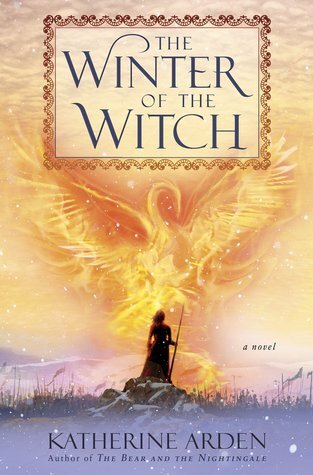

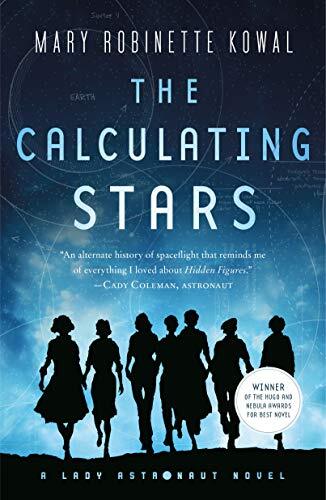
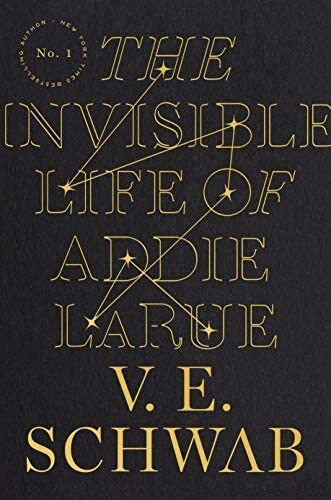
The Winter of the Witch by Katherine Arden
The exciting conclusion to the Winternight Trilogy. Moscow has been struck by disaster. Its people are searching for answers and for someone to blame. Vasya finds herself alone and beset on all sides. The Prince is in a rage. A wicked demon returned, stronger than ever, and caught in the center is Vasya.
Mexican Gothic by Silvia Moreno-Garcia
After receiving a frantic letter from her cousin begging her to save her from doom, Noemi heads to High Place, a house in the Mexican countryside. She is not sure what she will find – her cousin’s husband, a handsome Englishman – is a stranger. Noemi is an unlikely rescuer with her past as a debutante, but she is tough and smart with an indomitable will. And she is not afraid.
The Calculating Stars by Mary Robinette Kowal
On a cold spring night in 1952, a huge meteorite fell to earth and obliterated the east coast of the US. The ensuing climate cataclysm will soon render the earth inhospitable. This looming threat calls for a radically accelerated effort to colonize space and requires a march larger share of humanity to take part.
The Invisible Life of Addie LaRue by V.E. Schwab
In a moment of desperation, a young woman makes a Faustian bargain to live forest and is cursed to be forgotten by everyone she meets. Thus begins the extraordinary life of Addie LaRue. How far will she go to leave her mark on the world? What will she do when she stumbles into a bookstore where a young man remembers her name?

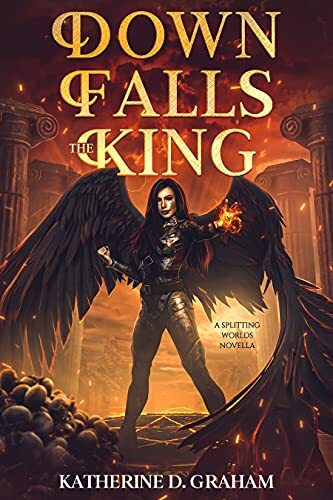
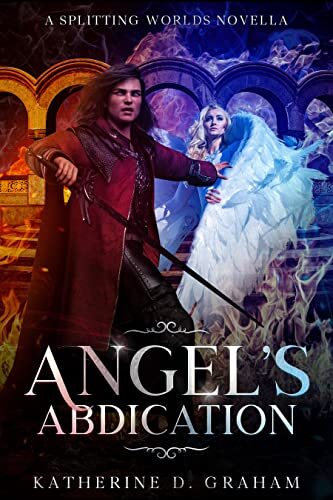
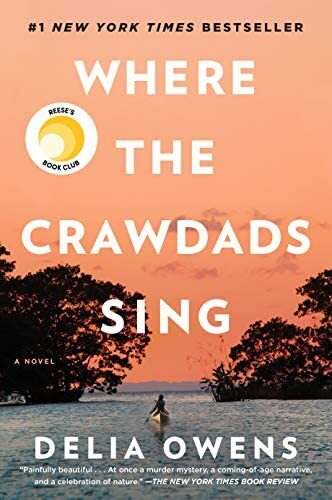
The Midnight Library by Matt Haig
Between life and death, there is a library, and within that library, the shelves go on forever. Every book provides a chance to try another life you could have lived. A novel about all the choices that go into a life well lived. Nora Seed finds herself in this library. Faced with the possibility of changing her life and living a new one. She must travel through the library to decide what is truly fulfilling in life.
Down Falls the King by Katherine D. Graham
Tengu Princess Rei is going to the Underworld for one reason – she is going to kill the Devil. It’s been 500 years since Lucef infiltrated the Tengu kingdom and destroyed Rei’s world. Now under a special moon, Rei seized her chance to steal back what is rightfully hers – her sister’s soul.
Angel’s Abdication by Katherine D. Graham
When Seracuse, the Angel crown princess, discovers she has been betrothed to the Devil, she knows she must run away to avoid life at his mercy. Abdicating the Angel throne is not easy with both the Heavens and the Lower World on her tail.
Where the Crawdads Sing by Delia Owens
For years, rumors of the “Marsh Girl” haunted Barley Cove. Kya Clark is barefoot and wild, unfit for society. So when popular Chase Andrews is found dead, locals point the finger at her. But Kya is more than they say. Can she prove her innocence?
*I am aware there is a controversy surrounding the author’s family. It is unclear what she knew – if anything – about the murders in Zambia. She is not a suspect in the case.*
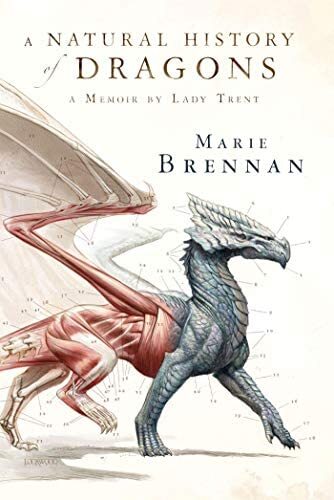
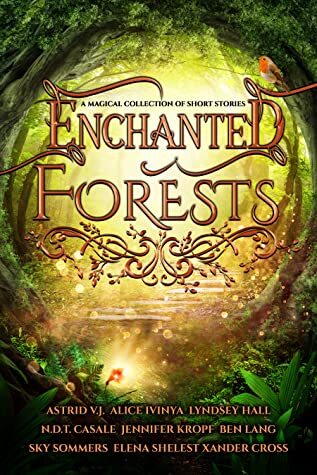


The Natural History of Dragons by Marie Brennan
All the world knows Lady Isabella Trent to be the world’s preeminent dragon naturalist. Here at last, in her own words, is the true story of her adventures as she risked life and limb to satisfy her scientific curiosity. Starting with her thrilling expedition to the perilous mountains of Vystrana where she made the first of many discoveries that changed the world forever.
Enchanted Forests Anthology
If you go into the woods today… You’d better not go alone. Discover the secret world between the trees where fairies, unicorns, and monsters dwell. A collection of short stories with all proceeds going to charities benefiting the Rainforest.
The Slayer Queen by Katherine D. Graham
Darkness and flames are coming. The fanged shadows within want only one thing: control of the world. In a world ravaged by Vampires, only Alara, the vampire queen stands between the hordes and humanity. But ghosts of her past aren’t ready to release their hold on her.
The Anthropocene Reviewed by John Green
The Anthropocene is the current geological age, in which human activity had profoundly shaped the planet and its biodiversity. This is a collection of essays reviewing different facets of humanity from the QWERTY keyboard to the Penguins of Madagascar on a five star scale.

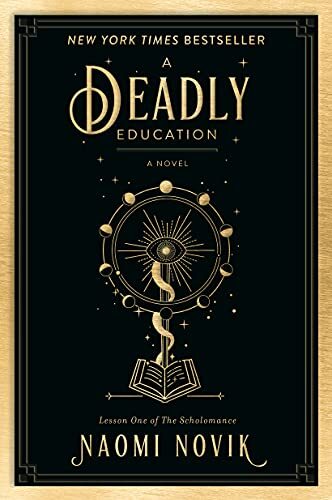

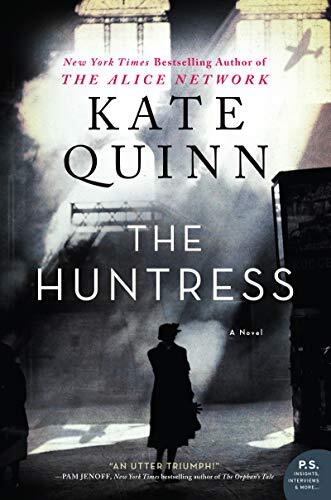
Scrappy Little Nobody by Anna Kendrick
A collection of autobiographical essays about Anna Kendrick’s rise to fame, struggle with auditions, dating, and more. With her stories of candor and wry observations.
A Deadly Education by Naomi Novik
Learning has never been this deadly. There are no teachers, no holidays, and no friendships – save strategic ones. Survival is more important than grades for the school won’t let them leave until they graduate or die. El is uniquely prepared for this danger with her power strong enough to wipe out millions. Her problem is the other students.
*I know of the previous version of this book that had racist passages in it. The version I read was the modified version after the author removed the offensive passages and a promise to do better in the future.*
All That She Carried: The Journey of Ashley’s Sack, a Black Family Keepsake by Tiya Miles
In a display case in the Smithsonian is a rough cotton bag stitched with a handful of words that evoke a family story of loss and love, passed down through generations. In 1850’s South Carolina, an enslaved woman named Rose gave this sack filled with a few precious items to her daughter as she was sold. This book tries to track down the family through the annals of history.
The Huntress by Kate Quinn
Nina Markova always dreamed of flying. When the Nazis attack the Soviet Union, she risks everything to join the Night Witches. When she is stranded behind enemy lines, Nina becomes the prey of a lethal Nazi murderess known as the Huntress. Only Nina’s bravery and cunning can keep her alive.
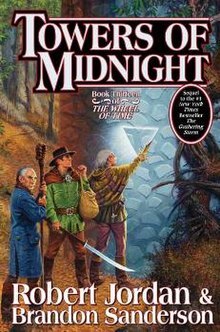

Towers of Midnight by Robert Jordan and Brandon Sanderson
Book 13 of the Wheel of Time. The Last Battle has started. The seals are crumbling and the Pattern is unraveling. The armies of the Shadow have begun to boil out of the Blight. The sun is setting on the Third Age. Mat Cauthon prepares for the most difficult challenge of his life. The creatures beyond the stone gateways – the Aelfinn and Eelfin – have a friend held captive. He must enter the Tower of Ghenjei to save her.
The Hate U Give by Angie Thomas
16 year old Starr Carter moved between two worlds – the poor neighborhood where she lives and the rich prep school she attends. The balance is shattered when she witnesses her childhood best friend shot at the hands of police. Soon his death makes national headlines with people protesting in his name. But what Starr does or doesn’t say could upend her community and endanger her life.
** The Realm of Darkness Box set was not included in this because I have not finished all 35 books, even though I have rated the set 5 stars on Goodreads **
2022 Pop Sugar Reading Challenge- Final Update!

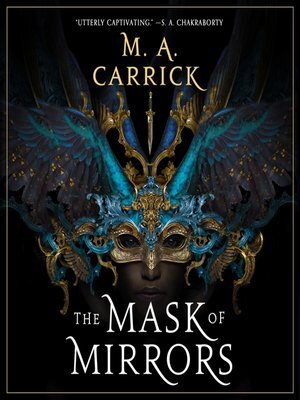

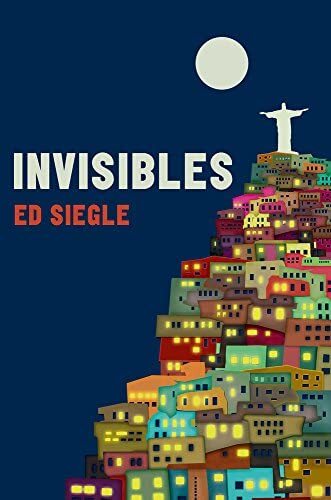
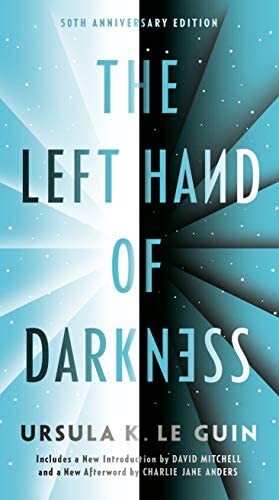
A book with “mirror” in the title: The Mask of Mirrors by M.A. Carrick
2 Stars
Ren is a con artist who has come to the sparkling city of Nadezra with one goal: to trick her way into a noble house and secure her and her sister’s future. But she realized her masquerade is just one of the many surrounding her.
An Anisfield-Wolf book award winner: All that She Carried by Tiya Miles
5 Stars
In a display case in the Smithsonian is a rough cotton bag stitched with a handful of words that evoke a family story of loss and love, passed down through generations. In 1850’s South Carolina, an enslaved woman named Rose gave this sack filled with a few precious items to her daughter as she was sold. This book tries to track down the family through the annals of history.
A book set in a twin city (Istanbul and Rio de Janeiro): The Invisibles by Ed Siegle
3 Stars
Joel has always believed his father was alive. His mother -Jackie – has long been glad to know he was gone. When a sighting on a news report from Rio de Janeiro suggests Joel might be right, he travels to Brazil to find his father.
A book about gender identity: The Left Hand of Darkness by Ursula Le Guin
3 Stars
A lone human emissary is sent to the planet of Winter where the inhabitants can choose- and change- their gender. His goal is to facilitate their inclusion into the growing collation of plants. But to do so he must bridge the gulf between his own views and those of the new culture.
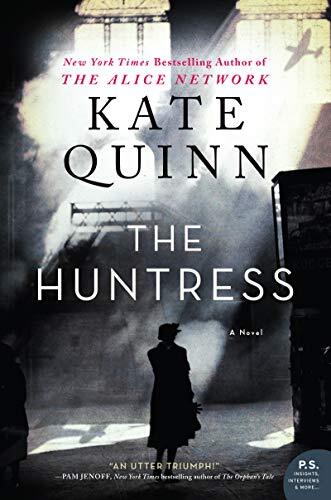
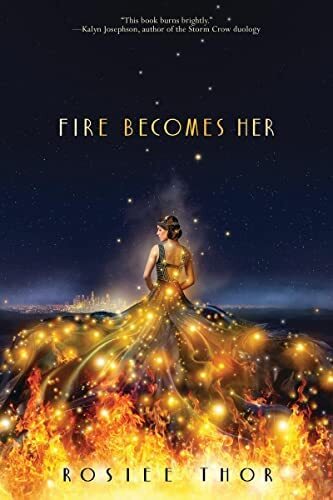


A book set on a plane, train, or cruise ship: The Huntress by Kate Quinn
5 Stars
Nina Markova always dreamed of flying. When the Nazis attack the Soviet Union, she risks everything to join the Night Witches. When she is stranded behind enemy lines, Nina becomes the prey of a lethal Nazi murderess known as the Huntress. Only Nina’s bravery and cunning can keep her alive.
A book published in 2022: Fire Becomes Her by Rosiee Thor
4 Stars
In this Jazz Age Fantasy, a politically savvy teen must weigh her desire to climb the social ladder against her heart where magic buys votes.
A book with the name of a board game in the title: Thunderhead (Scythe Book 2) by Neal Shusterman
4 Stars
Rowan has gone rogue and taken it upon himself to put the Scthedom through a trial by fire. Citra is now a junior scythe under Scythe Curie and sees the corruption of the system. She wants to help change it from the inside. Citra realizes she cannot do it by herself. Can she stop the scythes from destroying themselves?
A book set in the 1980s: Leaving Atlanta by Tayari Jones
3 Stars
A coming of age story of three young black children set against the backdrop of the Atlanta child murders of the 1980s.

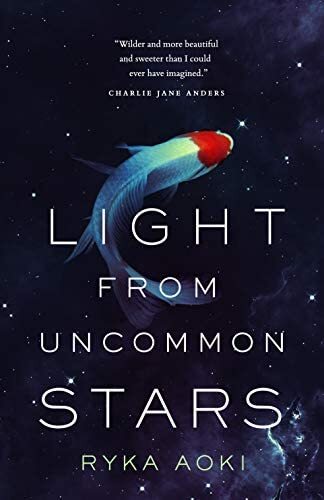
A book featuring a parallel reality: A Conjuring of Light by V.E. Schwab
4 Stars
Book 3 in this series. The balance of power between the four Londons has tipped. Once brimming with red magic, darkness casts a shadow over the Maresh Empire, leaving space for another London to rise.
A book with a constellation on the cover: Light from Uncommon Stars by Ryka Aoki
4 Stars
An adventure set in San Gabriel Valley, with cursed violins, Faustian bargains, and a queer alien courtship over fresh-made donuts. Shizuka Satomi made a deal with the devil. In exchange for seven souls, she would escape damnation. She has delivered six and is in search of her seventh.
October 24, 2022
Will-o’-the-Wisps

The Will-o’-the-wisp is a ghost light seen by travelers at night, especially over bogs, swamps, or marshes. The phenomenon in English folk belief is also referred to as the Friar’s Lantern or hinkypunk. The light is said to mislead travelers and are associated with fairies.

The stories of Will-o’-the-wisps can be traced in written record to the early 19th century though they were in the oral lexicon much earlier than that. In A Dictionary of Fairies, author K.M. Briggs notes that these fairies can be observed primarily in graveyards and bogs and calls them “ghost candles.”
The will-o’-the-wisp can be found in folktales around the world including Britain, the Americas, and even China. These phantom lights appear in marsh environments luring people into danger. In some stories, the lights even represent good and evil.
So what are these strange lights?
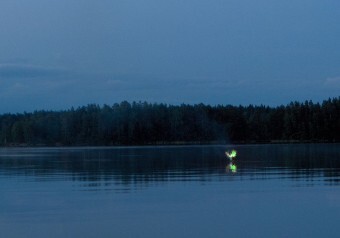
Historians believe that will-o’-the-wisps are etiological folk tales or a myth used to describe the natural world. Several theories exist as to the cause of the phantom lights. One of the most commonly accepted theories was discovered by Allesandro Volta in 1776 with his discovery of methane.
Volta proposed that electricity in the air mixed with swamp gas causing the ghost lights. At the time of his proposal, it was considered extremally controversial. It was disregarded because of the unlikeliness of spontaneous combustion and people saw the lights retreat when approached.

Today, scientists can prove Volta’s theory more or less accurate. Will-o’-the-Wisps are caused when organic matter breaks down in persistently wet areas – such as bogs or swamps. The movement of the wisps can be explained by the dispersal of the gas by the air currents.
As the gases from the break down of organic material rise and escape into the atmosphere, the methane mixes with phosphines and creates the blue lights seen hovering over the swamp. These phosphines are flammable and can burst into flame in the presence of oxygen. This produces the dense blue and white cloud that people describe as the Will-o’-the-wisps.

All of the stories of these phantom lights are explained as something supernatural. However, even back in the 18th century, there were explanations based in scientific theory for these ghostly lights.
Sources:
Geller, Sans’, .tdb-post-meta{margin-bottom:16px;color:#444;font-family:’O., Geller, P., By, & Geller, P. (2017, January 19). Will-o’-the-Wisp – Ghost Light at night. Mythology.net. Retrieved October 22, 2022, from https://mythology.net/mythical-creatures/will-o-the-wisp/
Surfandsunshine. (2022, September 6). The legend behind the will o the wisp in brave. Surf and Sunshine. Retrieved October 22, 2022, from https://www.surfandsunshine.com/will-o-the-wisp-brave/
Upton, E. (2013, April 20). What causes will-o’-the-wisps. Today I Found Out. Retrieved October 22, 2022, from http://www.todayifoundout.com/index.php/2013/04/what-causes-will-o-the-wisps/



